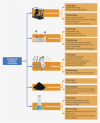Recovery and utilization of crude glycerol, a biodiesel byproduct
- PMID: 36320273
- PMCID: PMC9523763
- DOI: 10.1039/d2ra05090k
Recovery and utilization of crude glycerol, a biodiesel byproduct
Abstract
Biodiesel production has increased significantly in the past decade because it has been demonstrated to be a viable alternative and renewable fuel. Consequently, the production of crude glycerol, the main byproduct of the transesterification of lipids to biodiesel, has risen as well. Therefore, the effective recovery and utilization of crude glycerol can provide biodiesel with additional value. In this review, we first summarized the state-of-the-art progress on crude glycerol recovery and purification. Subsequently, numerous approaches have been reviewed for the utilization of crude glycerol, including use as animal feeds, for combustion, anaerobic fermentation, and chemical conversion. Finally, an extensive discussion and outlook is presented in relation to the techniques and processes in the chemical conversion of crude glycerol.
This journal is © The Royal Society of Chemistry.
Conflict of interest statement
There are no conflicts to declare.
Figures









Similar articles
-
Value-added uses for crude glycerol--a byproduct of biodiesel production.Biotechnol Biofuels. 2012 Mar 14;5:13. doi: 10.1186/1754-6834-5-13. Biotechnol Biofuels. 2012. PMID: 22413907 Free PMC article.
-
Effect of impurities in biodiesel-derived waste glycerol on the performance and feasibility of biotechnological processes.Appl Microbiol Biotechnol. 2012 Jul;95(1):13-27. doi: 10.1007/s00253-012-4111-3. Epub 2012 May 13. Appl Microbiol Biotechnol. 2012. PMID: 22581036 Review.
-
Integrated production for biodiesel and 1,3-propanediol with lipase-catalyzed transesterification and fermentation.Biotechnol Lett. 2009 Sep;31(9):1335-41. doi: 10.1007/s10529-009-0025-2. Epub 2009 May 23. Biotechnol Lett. 2009. PMID: 19466559
-
Microbial conversion of glycerol: present status and future prospects.Crit Rev Biotechnol. 2012 Sep;32(3):235-62. doi: 10.3109/07388551.2011.604839. Epub 2011 Sep 27. Crit Rev Biotechnol. 2012. PMID: 21950482 Review.
-
Economic and environmental evaluation for a closed loop of crude glycerol bioconversion to biodiesel.J Biotechnol. 2023 Mar 20;366:65-71. doi: 10.1016/j.jbiotec.2023.03.001. Epub 2023 Mar 11. J Biotechnol. 2023. PMID: 36907357
Cited by
-
Glycerol Electro-Oxidation in Alkaline Medium with Pt-Fe/C Electrocatalysts Synthesized by the Polyol Method: Increased Selectivity and Activity Provided by Less Expensive Catalysts.Nanomaterials (Basel). 2023 Mar 25;13(7):1173. doi: 10.3390/nano13071173. Nanomaterials (Basel). 2023. PMID: 37049266 Free PMC article.
-
Producing polyglycerol polyester polyol for thermoplastic polyurethane application: A novel valorization of glycerol, a by-product of biodiesel production.Heliyon. 2023 Aug 25;9(9):e19491. doi: 10.1016/j.heliyon.2023.e19491. eCollection 2023 Sep. Heliyon. 2023. PMID: 37662775 Free PMC article.
-
Synthesis and Optimization of Glycerol Carbonate from Crude Glycerol Using Sodium Carbonate (Na2CO3) as a Heterogeneous Catalyst.ACS Omega. 2023 Dec 14;8(51):48904-48914. doi: 10.1021/acsomega.3c06287. eCollection 2023 Dec 26. ACS Omega. 2023. PMID: 38162732 Free PMC article.
-
Recovery of potassium salt by acidification of crude glycerol derived from biodiesel production.RSC Adv. 2024 Feb 19;14(9):6112-6120. doi: 10.1039/d3ra08264d. eCollection 2024 Feb 14. RSC Adv. 2024. PMID: 38375015 Free PMC article.
References
-
- Saladini F. Patrizi N. Pulselli F. M. Marchettini N. Bastianoni S. Renewable Sustainable Energy Rev. 2016;66:221–227.
Publication types
LinkOut - more resources
Full Text Sources
Miscellaneous

